China’s Tech Infrastructure, Strengths, Policies, and Major Tech Breakthroughs Explained
Why Does China Vigorously Develop UHV (Ultra-High Voltage)?
First of all, what is the common infrastructure of 5G, big data centers, industrial Internet, and electric vehicle charging piles?
The construction and operation of these technologies are inseparable from the power network. Taking 5G as an example, the number of base stations will be 4 to 5 times higher than 4G, and the power consumption of each base station will be more than three times that of 4G base stations. This means that the power consumption of 5G will be 12 to 15 times that of the 4G era.
UHV transmission technology contains two technical forms: ultrahigh voltage (UHV) alternating current (AC) and UHV direct current (DC) transmission. The purpose is to further enhance the power transmission and distribution capacity, complete large-scale, long-distance power transmission, so as to better and more smoothly interconnect the regional power networks and better allocate resources. The transmission voltage of UHV AC transmission system is 1,000 kV AC, and the voltage of UHV DC transmission system is ±800 kV DC.
China has the world’s first UHV power grid line. It starts from Changzhi substation in Shanxi Province, passes through Nanyang switch station in Henan Province, ends at Jingmen substation in Hubei Province, and is connected to North China and Central China power grids, with a total length of 654 km and a declared cost of 5.86 billion yuan, about 920.5 million U.S. dollars. It was completed on December 28, 2008 for commercial operation. This line is completely independently developed, designed, and constructed by China with independent intellectual property rights of the 1,000 kV AC power transmission project.
The 1,100 kV is the world’s leading technology, and all the machinery and equipment are made in China.

The UHV DC grid
Source: Chinadialogue.net.
According to data from the State Grid of China, the primary UHV DC grid can transmit 6 million kW of electricity, which is equivalent to about five times that of the existing 500 kV DC grid. The transmission distance is also 2 to 3 times that of the latter, saving 60 percent of land resources.
UHV Is an Integral Part of China’s Economic Growth
According to the latest caliber of the Ministry of State Grid Infrastructure, the annual investment scale of UHV construction projects of the State Grid Corporation is 181.1 billion yuan (about 28.4 billion U.S. dollars), which can drive social investment of 360 billion yuan (about 56.5 billion U.S. dollars), and the overall scale is 541.1 billion yuan (about 84.92 billion U.S. dollars), providing a double-digit growth year-on-year.
According to a report from China Business News, in 2020, more than 550,000 5G base stations were opened nationwide in China.
In addition, according to Sadie Consulting, one of the top 10 management consulting companies in China, there were about 74,000 data centers in China in 2019, accounting for about 23 percent of the global total.
In terms of charging piles, the New Energy Vehicle Industry Development Plan (2021~2035) released by the Ministry of Industry and Information Technology of China at the end of 2019 shows that by 2025, the sales of electric vehicles will account for 25 percent of new vehicle sales. By 2030, the number of electric vehicles in China will reach 64.2 million units. According to the construction target of 1:1 vehicle-to-pile ratio, there will still be a 63 million shortage of charging pile construction in China in the next 10 years.
Whether it is dense 5G network base stations, big data centers, or charging piles all over the place consume a lot of power. The construction of UHV is crucial to meet the huge demand for electricity for China’s economic development.
What Are China’s Technological Strengths?
The advantages of China’s science and technology are mainly reflected in the following aspects:
The first is the ability to rapidly scale. According to the United Nations Industrial Classification, the world industry can be divided into 41 major categories, 207 medium categories, and 666 subcategories. At present, China is the only country in the world that has all the industrial categories in the United Nations Industrial Classification. China not only has a complete industrial system, but also ranks first in the world in terms of output value.
The second is the supply chain system. Electric car maker Tesla has benefited from China’s auto industry chain. On January 7, 2019, the Tesla Shanghai mega-factory broke ground. From signing the contract to acquiring the land, it took three months; it took eight months from the construction of the factory to the rollout of the first body-in-white.
Another example is the drone company DJI, founded in 2006 and headquartered in Shenzhen, China.1 DJI currently accounts for more than 70 percent of the global drone market. In addition to the company’s advanced design concept, another important reason for DJI to become the global leader in consumer drones is Shenzhen’s supply chain system. For drones, sensors are key components, and the cost has dropped sharply in recent years. One of the reasons is that the world’s famous smartphones are mass-produced and assembled in Shenzhen. In addition, there were many factories producing fishing rods, tennis rackets, and badminton rackets in Shenzhen in the early years. One of the raw materials for these products was carbon fiber. The main material of the drone is carbon fiber.
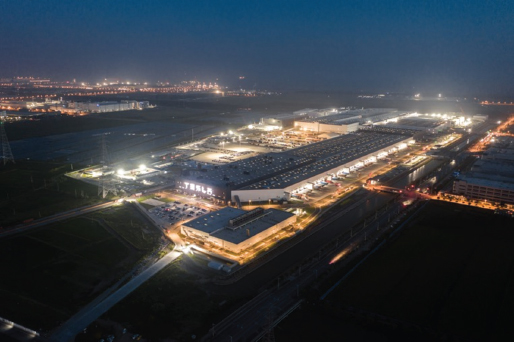
Tesla Shanghai Factory
Source: www.yicai.com.

DJI drone
Source: DJI.
The third advantage is the strong funding support. According to a report by Wang Zhigang, Minister of China’s Ministry of Science and Technology, China’s entire society’s R&D investment reached 2.79 trillion yuan (about 437.8 billion U.S. dollars) in 2021, a year-on-year increase of 14.2 percent. The intensity of R&D investment (the proportion of R&D investment in GDP) reached 2.44 percent, and the overall ranking of national innovation capacity rises to 12th in the world.
Made in China 2025
Made in China 2025 is a strategic document signed and approved by Premier Li Keqiang and issued by the State Council in May 2015 to comprehensively promote the implementation of a manufacturing powerhouse. Made in China 2025 was formulated by more than 100 academicians and experts to design a top-level plan and roadmap for China’s manufacturing industry in the next 10 years. It aims to realize the three major changes from Made in China to Created in China, China Speed to China Quality, and China Products to China Brand, and to promote China’s basic industrialization by 2025 and move into the ranks of manufacturing power.
The goal of China’s science and technology development is to bring China to the forefront of innovative countries by 2030, and to make China a world power in science and technology by the 100th anniversary of the founding of the People’s Republic of China.
Science and technology innovation is a system project that requires the innovation chain, industry chain, capital chain, and policy chain to intertwine and support each other.
One of China’s strengths is that its political system is able to focus its efforts. However, the government’s decision-making needs to be based on scientific and technological consultation and science and technology think tanks, with advice from science and technology experts in various aspects. It also needs to improve the budget and resource management of science and technology projects to maximize the efficiency of science and technology innovation activities.
In addition, enterprises are an important force closely integrating technology and economy, and should become the main body of technology innovation decision making, R&D investment, scientific research, and achievement transformation. How to encourage enterprises’ technological innovation, strengthen support for small and medium-sized enterprises’ (SMEs’) technological innovation, curb anti-monopoly and unfair competition, enhance the protection of patented technologies, and so on. These all require the Chinese government to optimize the relevant management system.
Top 10 Scientific and Technological Progress in China in 2021
1. China’s First Mars Exploration Mission a Complete Success
On June 11, 2021, the China National Space Administration held the unveiling ceremony of the first scientific images of the Tianwen-1 probe landing on Mars in Beijing and Patrol Group Photo and other images.

The orbiter and Mars
Source: The National Space Administration.
The release of the first batch of scientific images marks the complete success of China’s first Mars exploration mission. It is reported that China’s first Mars exploration mission was fully launched in 2013 for demonstration, and the project was approved in January 2016. On July 23, 2020, the Tianwen-1 probe was successfully launched in Wenchang, Hainan. After the ground fire transfer, Mars capture, Mars berthing, de-orbit landing, and scientific exploration, the engineering mission was carried out smoothly as planned.
2. China’s Space Station Opens Era of Manned Long-Term Residency
On June 17 and October 16, 2021, Shenzhou XII and XIII manned spacecraft were successfully launched, successfully sending astronauts into space. Shenzhou XII docked with Tianhe core module to form a combination. Three astronauts were stationed in the core module for a three-month stay, carrying out a series of space science experiments and technology tests, and verifying in orbit the key technologies for space station construction and operation, such as long-term astronaut stationing, regenerative life preservation, space material resupply, outboard activities, extravehicular operations, and in-orbit maintenance.
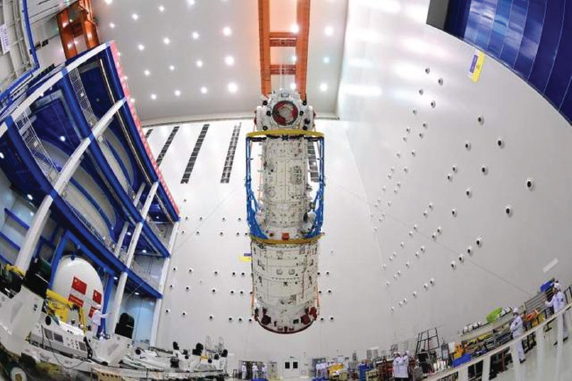
Heaven and the core module
Source: The Fifth Academy of Space Science and Technology Group.
After Shenzhou 13 entered orbit, it completed an autonomous and rapid rendezvous with the Tianhe core module and the Tianzhou-2 and Tianzhou-3 assemblies. The three astronauts started a six-month on-orbit stay, during which they carried out mechanical arm operation, out-of-the cabin activities, module transposition, space science experiments, and technology tests, to further verify a series of key technologies such as astronauts’ long-term in-orbit residency and regeneration and life protection. The era of long-term residency in the Chinese space station has arrived.
3. China Realizes De Novo Synthesis of Carbon Dioxide to Starch
Starch is the main carbohydrate in porridge and rice and is a major component of flour, rice, corn, and other grains, as well as an important industrial raw material. Its main synthesis method is carried out by green plants fixing carbon dioxide through photosynthesis. For a long time, researchers have been working hard to improve the life process of photosynthesis, hoping to increase the conversion rate of carbon dioxide and the utilization efficiency of light energy, and ultimately improve the production efficiency of starch.

Researchers observe synthetic starch in a test tube
Source: Science and Technology Daily.
Researchers at the Tianjin Institute of Industrial Biotechnology of the Chinese Academy of Sciences have proposed a disruptive starch preparation method that does not rely on plant photosynthesis and successfully produces starch from carbon dioxide and hydrogen produced by electrolysis, achieving the first international ab initio synthesis of carbon dioxide to starch, making it possible to transform starch production from the traditional agricultural cultivation mode to the industrial workshop production mode and making an original breakthrough. Relevant research results were published online in the journal Science on September 24, 2021.
4. Chinese Team Won 2021 “Gordon Bell Award” for Its Supercomputing Application That Broke “Quantum Hegemony”
On November 18, 2021, at the Global Supercomputing Conference (SC21) held in St. Louis, Missouri, United States, the Association for Computing Machinery (ACM) awarded the 2021 Gordon Bell Award to the Chinese supercomputing application team.
The team, composed of researchers from Zhijiang Laboratory and the National Center for Supercomputing in Wuxi, received the award for their work on Super-Scale Quantum Stochastic Circuit Simulation in Real Time (SWQSIM), an application based on the next-generation Shenwei supercomputer.
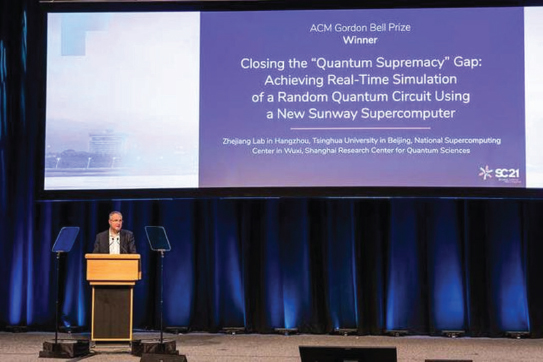
The award site, Wuxi
Source: Zhijiang Laboratory and National Supercomputing Centre.
Using a new generation of Sunway supercomputers, the research team effectively simulated a random quantum circuit with a depth of 10 × 10(1+40+1). Compared with Google’s quantum computer Hoverwood to complete a million 0.2 percent fidelity sampling task in 200 seconds, Vertex needs 10,000 years to complete a simulation of the same complexity, and the team’s SWQSIM application can obtain one million updates in 304 s. High-fidelity correlated samples, with the same number of uncorrelated samples obtained within a week, broke its claimed quantum supremacy in one fell swoop.
5. 1,400 Trillion Electron Volts Highest Energy Photon Ever Observed by Chinese Scientists
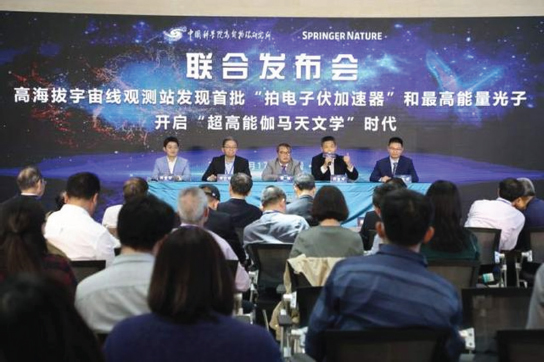
The Institute of High Energy Physics (IHP) of the Chinese Academy of Sciences (CAS) and Springer Nature jointly held a press conference on major scientific achievements
Source: People’s Daily, on May 17, 2021.
An international collaboration led by the Institute of High Energy Physics of the Chinese Academy of Sciences (IHP), relying on the National Major Science and Technology Infrastructure High Altitude Cosmic Ray Observatory (LHAASO), has discovered 12 ultra-high energy cosmic ray gas pedals in the Milky Way galaxy and recorded gamma photons with an energy of 1.4 beat electron volts (PeV, beat = trillion), which is the highest energy photon ever observed by humans. This is the highest energy photon observed by mankind so far, breaking through the traditional human perception of particle acceleration in the Milky Way, revealing the prevalence of cosmic line gas pedals in the Milky Way capable of accelerating particles to more than 1 PeV, opening the era of ultra-high energy gamma astronomy observation. The related results were published in Nature on May 17, 2021.
6. Important Research Results of Chang’e-5 Samples Have Been Released Successively
On October 19, 2021, the Chinese Academy of Sciences (CAS) released the latest research results from Chang’e-5 lunar research samples. Led by the Institute of Geology and Geophysics and the National Astronomical Observatory of the Chinese Academy of Sciences, the breakthroughs around important scientific questions on the evolution of the Moon are reported through three Nature papers and one National Science Review paper, in collaboration with several research institutions.
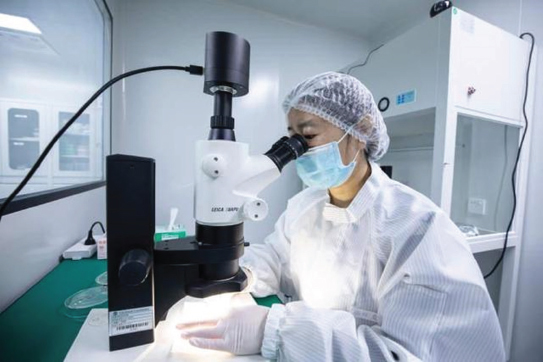
Microscopic selection of micron-sized particles in lunar soil
Source: People’s Daily.
In the latest study, researchers used ultra-high spatial resolution uranium-lead (U-Pb) dating techniques to analyze more than 50 uranium-rich minerals (plagioclase, calcitic zircon, and jacobite) in the basaltic debris of Chang’e-5 lunar samples. The age of basalt formation was determined to be 2.03 ± 0.04 billion years, indicating that the Moon was still magmatic until two billion years ago, which is about 800 million years longer than the magmatic activity limited by previous lunar samples.
The study shows that the basalt of the Chang’e-5 lunar sample was not involved in the Crip material enriched in potassium, rare earth elements, and phosphorus during the initial melting. In the later stage of the magma, after a large number of minerals were crystallized and solidified, the residual part was enriched. This result ruled out the mainstream hypothesis that the initial magmatic melting heat source of the rocks in the Chang’e-5 landing area came from radioactive heat-generating elements, and revealed the late lunar magmatic activity process. It is reported that the dating and isotope analysis techniques with ultra-high spatial resolution used in this study are at the international leading level, providing new technical methods for the chronology of precious extraterrestrial samples and other studies.
7. New Breakthrough in Rapid Ab Initio Domestication of Allotetraploid Wild Rice
With the rapid growth of the world’s population, food production may increase by 50 percent by 2050 to fully meet demand. At the same time, the world’s climate change has intensified in recent years, and global warming and frequent extreme weather have posed enormous challenges to food security.

Plant phenotypes of allotetraploid wild rice and diploid cultivated rice
Source: People’s Daily.
In this context, how to further improve crop yields has become a serious problem that needs to be solved. The team of academician Li Jiayang from the Institute of Seed Innovation/Institute of Genetics and Developmental Biology of Chinese Academy of Sciences has proposed a new strategy for rapid ab initio domestication of heterotetraploid wild rice for the first time, with the aim of eventually cultivating a new polyploid rice crop, thereby greatly improving food production. This research proposes a new and feasible strategy to deal with the food crisis in the future and opens up a whole new direction of crop breeding. The related research results were published in Cell on February 4, 2021.
8. China Successfully Developed –271°C Superfluid Helium Large-Scale Cryogenic Refrigeration Equipment
On April 15, 2021, the Institute of Physical and Chemical Technology of the Chinese Academy of Sciences (IPT) passed the acceptance and achievement appraisal of the national major research equipment development project Development of large cryogenic refrigeration system from liquid helium to superfluid helium temperature zone, marking that China has the capability to develop large cryogenic refrigeration equipment of kilowatt level for liquid helium temperature (–269°C) and superfluid helium temperature (–271°C). It can meet the urgent needs of national strategic high-technology development such as large scientific projects, aerospace projects, and helium resources development.
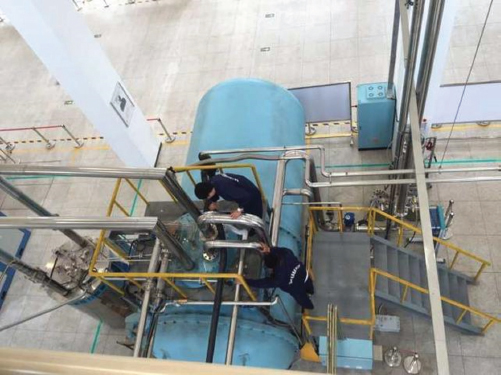
Large-scale cryogenic refrigeration systems
Source: People’s Daily.
The successful implementation of the project has also driven the rapid development of high-end helium screw compressors, cryogenic heat exchangers, and cryogenic valves in China. This project has improved the core competitiveness of a number of high-tech manufacturing enterprises, and enabled the related technologies to be improved from scratch, from low-end to high-end, and initially formed a low-temperature industry group with complete functions and clear division of labor in China.
9. First Demonstration of Functional Gene Transfer From Plant to Animal
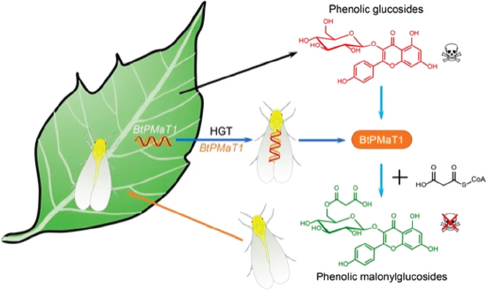
Institute of Vegetable and Flower Research, Chinese Academy of Agricultural Sciences
Source: Zhang Youjun’s team.
After 20 years of research, Zhang Youjun’s team from the Institute of Vegetables and Flowers Research, Chinese Academy of Agricultural Sciences has discovered the only super pest so far recognized by the Food and Agriculture Organization of the United Nations (FAO), the sooty fly. This is the first study to confirm the existence of functional horizontal gene transfer between plants and animals in the more than 100 years since the birth of modern biology.
10. Rare Earth Ions Enable Multimode Quantum Relay and 1-Hour Optical Storage
The law of quantum unclonability gives quantum communication security based on the principles of physics. This law also determines that the photon transmission loss cannot be overcome by using traditional amplifiers, making long-distance quantum communication one of the core problems of today’s quantum information science.
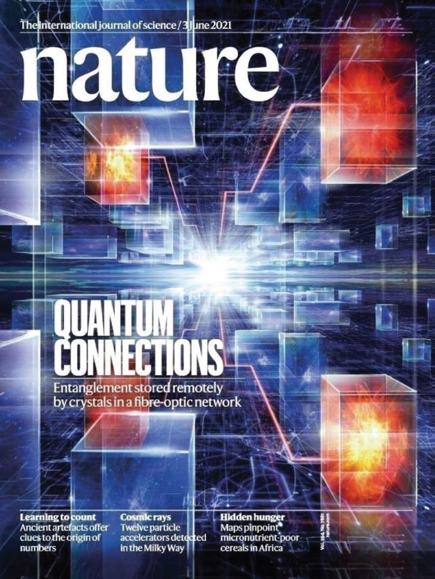
Multimodal quantum relaying of rare earth ions published as a Nature cover story titled Quantum Connections
Source: Nature.
Quantum relay and removable quantum storage are two feasible solutions to realize long-range quantum communication, whose common requirement is high-performance quantum memory. In quantum relay, international experimental research has focused on the architecture of emission-based memory, which cannot meet the two key technical requirements of deterministic luminescence and multimode multiplexing at the same time. In terms of removable quantum storage, the longest international optical storage time is only 1 minute, which cannot meet the demand of hourly storage time of removable quantum storage.
The research group of academician Guangcan Guo’s team at the University of Science and Technology of China (USTC), Chuanfeng Li and Zongquan Zhou, has developed a high-performance solid-state quantum memory based on rare-earth ion-doped crystals, and has made important progress in the aforementioned two technical routes, realizing a multimode quantum relay based on absorption-type memory and successfully increasing the optical storage time to 1 hour. The related results were published in Nature Communications and Nature on April 22 and June 2, 2021, respectively.
